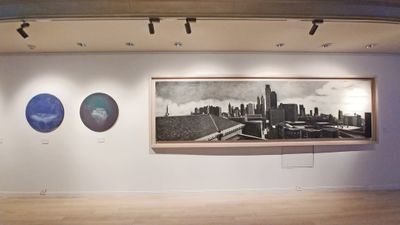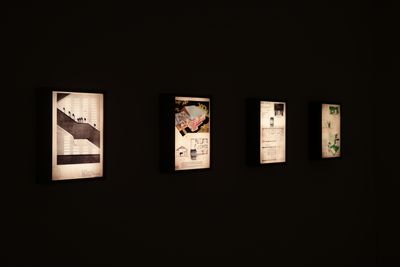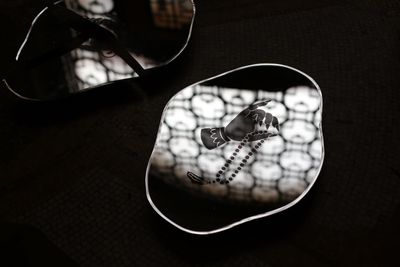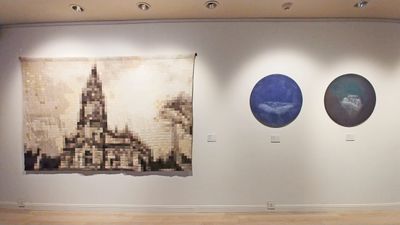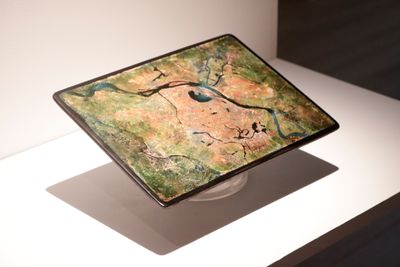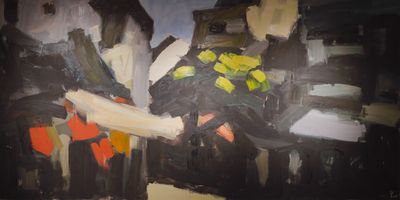Dreaming about Landscapes in Hanoi
Wearing a crown of light, Jesus rides a donkey into the centre of the painting. Behind him is a village, a bridge, and a crowd. In front, amid a clearing of trees, dark-haired onlookers watch him approach.
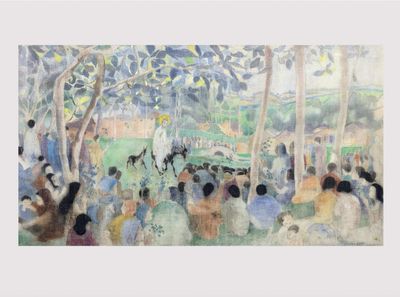
Alix Aymé, The Entry into Jerusalem (1950). Silk painting. 33 x 62 cm. Courtesy Mơ Art Space.
This is The Entry into Jerusalem, Alix Aymé's reimagining of an evangelical motif painted in 1950. As a French artist and professor at the Ecole des Beaux-Arts d'Indochine, where many modernist pioneers in the country trained, the painting marries traditional Eastern silk painting techniques with a Western colour palette.
The Entry into Jerusalem is one of the standout pieces from Dreaming about Landscapes, a group exhibition organised by Mơ Art Space in Hanoi (19 December 2020–23 January 2021).
As Mơ Art Space's founder Ngô Tấn Đức notes, the show presents art stretched across different eras of Vietnamese contemporary art. With 29 works by 23 artists curated by Đỗ Tường Linh, the exhibition asks viewers to contemplate the role of landscapes in modern-day Vietnam, from perspectives of idyllic patriotism to gritty realism.
Even though landscape painting is popular among art collectors in Vietnam as an easily accessible genre, it often comes across as outdated and tinged with nationalism. Dreaming about Landscapes shows an increasing number of contemporary Vietnamese artists returning to the form to revitalise and challenge it.
Sitting next to Aymé's painting is Bright Houses (2017–2020), a collection of light boxes by Ngọc Nâu. The work is based on architectural sketches from Saigon News articles in 1957 that depict mock-ups of a social reconstruction project for migrants from North Vietnam who migrated to the South looking for religious freedom. However, due to political unrest, these projects were cancelled.
Ngọc places herself in the images, riding escalators and standing in the blueprints of houses. 'I wanted to illustrate that the landscape has a human element, which forces people to live in a certain condition or framework,' the artist explains.
The high-rise buildings depicted in Ngọc's work have become commonplace in both Hanoi and Ho Chi Minh, Vietnam's biggest cities, where urbanisation has evolved with an expanding wealth gap: the wealthy live in high-rise buildings, while the poor live close the ground, amid polluted waters that run through the cities.
In Hanoi, lakes are an indispensable feature, not only in terms of geographical position, but as close links to religion and beliefs, where water is one of Asia's 'five elements'.
Works across Dreaming about Landscapes show a country on the rise and its landscapes changing over time...
When researching her project, artist Chi L. Nguyễn began to feel that her city was poisoning its religious resource, as its rivers and lakes became increasingly polluted. In the installation Lakes (2020), Chi uses the mirror painting technique—an increasingly uncommon medium—to depict symbols of Buddhism.
These nods to a changing city environment are intertwined throughout the exhibition, from Võ Trân Châu's Trà Cổ Cathedral (2019), that uses recycled fabrics to reimagine colonial architecture built towards the end of the 19th century, to Oanh Phi Phi's Outpost 6 and 7, from the series 'Pro Se' (2020), which explores the city's relationship with technology.
The tablet-like 'screen' in Outpost 6 and 7 recreates the view through an airplane window using light-refractive lacquer combined with gold and silver foil to emulate the qualities of a digital landscape.
In Hàng Bè Street (date unknown), Phạm Luận uses oil on canvas to draw the viewer into Hanoi's Old Quarter, capturing the historical urban core of the city with its small tile-roofed houses and rows of flowering trees.
Unlike Phạm Luận's usual work, which focuses on capturing reality through landscapes, this impressionist piece uses liberal lines and an abstract language, making the painting unique in its portrayal of a picturesque Hanoi in the time of transition after Vietnam's social reforms in 1986, Đổi Mới.
Works across Dreaming about Landscapes show a country on the rise and its landscapes changing over time: an exercise that is not only aesthetically valuable, but also necessary in today's social context.
'Landscape allows us to juxtapose artworks of past and present, how the subject is seen, imagined, and interpreted throughout history,' Đức said. In keeping, Dreaming about Landscapes reflects on how Vietnam has grown in the last century, from tranquil rice paddies to modernised cities.—[O]




